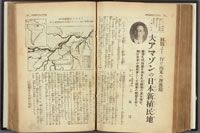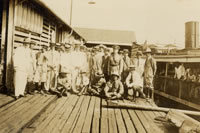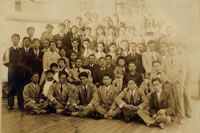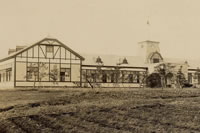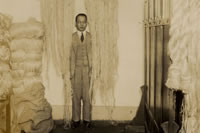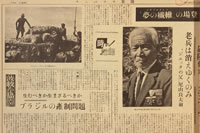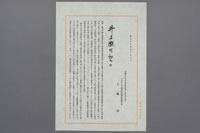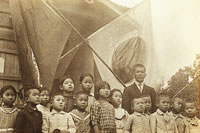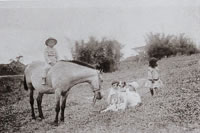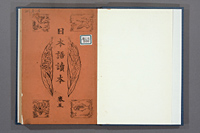Amazonia Industrial Research Center
Yamanishi and Awazu concessions
On March 11, 1927, Genzaburo Yamanishi, a young businessman from Tokyo and Kinroku Awazu who travelled to Brazil in 1914 and lived in Rio de Janeiro concluded an agreement with the State of Amazonas on the following terms for the gratuitous grant (concession) of one million ha of state-owned land from it.
- Yamanishi and Awazu should select one million ha of state-owned land in total within the region at their own expense within two years.
- Yamanishi and Awazu should establish an overseas company within one year of the selection.
- The said company should conclude an agreement with the State Government to construct a Japanese colony, which should be settled by 10,000 Japanese immigrant families at least within 50 years.
Yamanishi promptly returned to Japan and tried to raise funds for the Amazon development project, but in vain due to the financial panic.
Establishment of the Amazonia Industrial Research Center
Yamanishi and Awazu commissioned the rights under the agreement to House of Representatives member Tsukasa Uetsuka (a younger cousin of Uetsuka Shuhei) who was a native of the same prefecture, Kumamoto and a graduate of the same college, Kobe Koto Shogyo Gakko (Kobe Commerce College) as Awazu. Uetsuka sent survey teams two times to survey and select land in 1928 and 1930 (the 2nd team, the leader of which Uetsuka himself became, was dispatched with a Government grant). After the selection was made, a privately owned tract two miles downstream from Parintins City was purchased and named "Vila Amazonia" (Amazonia Village). The Amazonia Industrial Research Center was established in this tract on October 21, 1930 (incorporated in February 1933) with an agricultural experiment station, a meteorological observation station, a hospital and an industrial training school.
Colonization school
Meanwhile, in April 1930, Uetsuka established the Kokushikan Koto Takushoku Gakko (Kokushikan Colonization School, called "Kotaku" for short), offering a one-year course on the premises of Kokushikan in Tokyo in order to train middle-management leaders for Amazonia development. Since only those who have graduated from a junior high school or a higher school were admitted to the school, children of relatively wealthy families entered it. The first entering class of 47 graduates (including 2 leaders) left for the Amazon in April 1931 and arrived at Vila Amazonia in June and trained for a year at the training school.
In June 1932, Uetsuka severed ties with Kokushikan, which at the time was involved in military expansion into Manchuria, renamed the school the Nippon Koto Takushoku Gakko (Japan Colonization School) and moved the school to Noborito in Kanagawa Prefecture. The Colonization School sent its graduates to the Amazon until its 7th entering class graduated in 1937.
-
Articles in newspapers / magazines
-
 Departure of the first set of Kotaku (Kokushikan Koto Takushoku Gakko (Kokushikan Colonization School)) graduates from Yokohama
Departure of the first set of Kotaku (Kokushikan Koto Takushoku Gakko (Kokushikan Colonization School)) graduates from Yokohama -
Articles in newspapers / magazines
Successful jute cultivation and commercialization
In January 1933, Uetsuka dispatched Kotaro Tsuji, a graduate of the same college as him and Awazu, Kobe Koto Shogyo Gakko (Kobe Commerce College), as a successor of local director, Awazu who had left the research center at the end of the previous year. Tsuji arrived to assume his post in April and soon after taking office, began selecting land for the model colony suitable for cultivating mainly jute which was acknowledged to be the most promising, and began construction of a new colony in the Angela region in June. Jute cultivation began in the colony with the use of seeds smuggled out of India by Tsuji, but it resulted in a series of failures. In December 1933, Ryota Oyama, an igusa rush mat manufacturer from Okayama Prefecture and the father of a member of the second entering class of the Kotaku (Kokushikan Koto Takushoku Gakko (Kokushikan Colonization School)) graduates who had settled in the Amazon at the request of Uetsuka, found two different varieties of jute that exceptionally had grown extremely longer in a marsh near the colony. Seeds were extracted from one of these varieties to produce fiber, which turned out to be high quality.
The Amazonia Industrial Research Center successfully cultivated and commercialized jute in Brazil with these seeds. It shipped its first load of 60 bags (2,770kg) of jute in April 1937. Since before then, Brazil had used jute imported from India to make bags for shipping coffee and other agricultural exports, this success was highly praised in Brazilian newspapers as a great achievement of Japanese immigrants, and Uetsuka and Tsuji were allowed to have an audience with Brazilian President Vargas when he visited the Amazon on October 9, 1940.
Establishment of the Amazonia Industrial Company
The establishment of the company described in the concession agreement was behind schedule, but the conference at Prime Minister’s Office attended by the four major zaibatsu (industrial and financial business conglomerates) of Mitsui, Mitsubishi, Sumitomo and Yasuda and representatives of the Toyo Takushoku Kabushiki Gaisha (Oriental Colonization Company Limited) decided on September 17, 1935 to establish the Amazonia Industrial Company (with a capital of one million yen) (it was established on September 23, Tsukasa Uetsuka nominated as president). The company would succeed and take over all of the projects run in Brazil by the Amazonia Industrial Research Center with projects to be executed by the overseas affiliate company established in February 1936.
With the outbreak of the Second World War, the Amazonia Industrial Research Center was seized by the Brazilian Government as an enemy asset. The senior staff and their families which were not involved in jute cultivation were interned as hostile aliens in Tome-Acu.
Educational problems in Nisei (the second generation of Japanese immigrants)
Educational situations in Japanese schools in outlying regions
The biggest concern for immigrants who came to Brazil with the intention of earning money and then returning to Japan with it, was how to help their children master Japanese language so that they might not have any problems when returning to Japan. For this reason, elementary schools were firstly established at each of Japanese settlements. 61 schools by the end of 1926, 122 schools by June 1931 and 486 schools by March 1939 was established.
But it proved extremely difficult to teach reading and writing of Japanese language as well as the so-called "Japanese spirit" to the Nisei (the second generation of Japanese immigrants) and quasi-Nisei (the term used to refer to those who had lived in Brazil since their early childhood) in elementary schools in the outlying regions of São Paulo State in a quite different environment from that of Japan. In addition, while parents were too busy making a living to pay attention to their children's learning progress, children were too busy helping with household chores to have any dedicated study time.
It was also very difficult to employ good teachers in elementary schools in the outlying regions and the parents who had some financial leeway often sent their children to boarding schools in São Paulo City.
Leading educational organizations
In March 1927, a consulting meeting on the education of Japanese children in the State of São Paulo was called by the then Consul General Sukeyuki Akamatsu and held over three days to spread and improve the education in the state, in which about 60 persons concerned with schools in each region of the State of São Paulo took part. On the decisions of the meeting, the Council on Education of Japanese in Brazil was formed for the purposes of building mutual communication and support systems between schools, unifying educational policies for Japanese children, improving quality and employment conditions of teachers, holding classes and lectures on education, improving textbooks, improving school facilities and jointly procuring school supplies. The council, however, bore little fruits due to insufficient communication between the central office in São Paulo and directors elected by each branch, and it was replaced by the São Paulo Japanese School Parents' Association (Hereinafter referred to as the "Parents' Association") formed under the direction of Consul General Akamatsu's successor, Seiichiro Nakajima.
In addition to the activities already started by the council, the Parents' Association began to manage student dormitories constructed in São Paulo City, and became responsible for the distribution of educational grants provided by the Japanese Government (35,000 yen per year for school building construction and teachers’ salary).
In March 1936, the Parents' Association changed its name to the Association for the Spread of Japanese Education in Brazil, and was renamed again in October 1937 to the Association for the Spread of Japanese Culture and Education in Brazil.
-
Articles in newspapers / magazines
-
 Opening of the Katsurajin-kai Elementary School (Photo taken on the opening day)
Opening of the Katsurajin-kai Elementary School (Photo taken on the opening day) -
 Children playing in the colony
Children playing in the colony -
Articles in newspapers / magazines
São Paulo Japanese School Parents' Association (article published in a Japanese language newspaper)
-
 Japanese language reading book
Japanese language reading book

